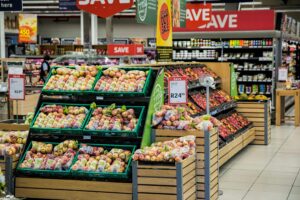A super shop is a self-serve store with many different food, drink, and home goods arranged into departments. One of Bangladesh’s expanding industries is the superstore sector. Super shop expansion in Bangladesh was accelerated by the nation’s urbanization, socioeconomic growth, and rising middle- and upper-class purchasing power.
The supermarket business started in the country after 2000, it took more than a decade to gain public acceptance. In 2001, Rahimafrooz Superstores Ltd. opened “Agora,” Bangladesh’s first superstore, adopting a Western idea. Rahimafrooz Superstores Ltd. established this supermarket. The “Gemcon group” introduced “Meena Bazar” the next year. “Shwapno” began operations in Bangladesh in 2006 as a sister company of ACI Limited. With more than 185 locations and 40,000 daily consumers, “Swapno” is now the largest supershop chain in Bangladesh in terms of number of outlets. Nevertheless, out of all of Shwapno’s locations, 61 are under the company’s ownership; the remaining locations are run by franchises. Additionally, Rahimafrooz’s Agora has eighteen sites nationwide, while the Gemcon Group’s “Meena Bazar” has eighteen outlets in Dhaka, Chittagong, and Sylhet.
Gemcon Group and Rahimafrooz were reportedly in talks to acquire all “Agora” locations, according to a 2020 Daily Star story. In addition, United Group’s “Unimart” has two express locations at United Hospital and United International University, and three locations in Dhaka at Gulshan, Dhanmondi, and Wari. Conversely, the Pran-RFL Group operates 51 Daily Shopping locations in Dhaka. Aside from this, Dhaka is home to a few more small superstore chains, such as two Prince Bazar stores and four Almas stores. The majority of the supershop retail locations can be found in major cities like Rajshahi, Sylhet, Chittagong, Dhaka, and Narayanganj.
Business Model
The business structures and revenue creation of supermarkets are heavily dependent on global product sales. Supermarkets then frequently purchase goods from both main and secondary sources. If supermarkets buy products straight from the manufacturer, without the need for an intermediary, they can do it at a reduced cost. Conversely, the price of buying the same quantity of goods increases because of middlemen. Super shops, on the other hand, are able to purchase goods in bulk for all of their outlets and have greater purchasing power than supermarkets. Superstores may therefore be able to purchase goods at a lower wholesale price than small retail establishments or grocery stores, even in the case of several intermediaries. As a result, supermarkets may generate more revenue at larger margins than small retail or food stores.
Supermarkets provide products with varying profit margins. Some local products can make less than 5% profit, whereas some imported products can make up to 50% profit, per one market analysis. Superstores usually turn a profit between 15% and 16 percent of total sales. Superstores commonly employ “bundle pricing” to increase revenue. Superstores can utilize this strategy to get rid of their inventory of slow-moving items by providing a “bundle” that includes both fast- and slow-moving items at a discounted price. Moreover, supermarkets provide “buy one, get one free” deals on a few products. Superstores are able to increase sales volume and make significant profit margins by using this strategy.
Key Players’ Country Origin
| 1. SHWAPNO |  |
| 2. AGORA |  |
| 3. MINA BAZAR |  |
| 4. CSD BANGLADESH |  |
| 5. PRINCE BAZAR | |
| 6. DAILY SHOPPING |  |
Current Market Share of Super shops
Major products of this segment
- Frozen chicken, fish, red meat & poultry
- All types of dairy item
- Ready to cook food (Frozen food)
- Confectionary Items
- Fruits & Vegetables
Future Opportunity
The purchasing power of the people in Bangladesh is rising daily. As per capita income climbed to USD 2227 this year from USD 2064, we may conclude that people’s disposable income is rising along with the desire of middle-class and upper-class consumers to make all of their purchases in one location. Consequently, there is a growing need for big stores across the nation. A study by Business Standard states that super shops will be constructed in all of Bangladesh’s district headquarters and suburban districts in order to accommodate the growing demand in the next five to ten years. Another TBS news article states that whereas Shwapno is expected to rise by 20% annually, typical cooking market sales are expected to grow by only 5-6% annually. This suggests that customers are shifting from traditional retail markets to supershops. Super Shop thus has a great deal of room to grow.
Supershops are relatively new in Bangladesh, however, in several wealthy nations, they are well-established. The biggest retail companies in the world will be drawn to Bangladesh if this industry grows successfully there. The superstore industry in Bangladesh would grow along with the size of the country’s overall retail market if these retail behemoths were to set up shop there. Traditional retail establishments are still in business, despite the global retail behemoths’ slow transition to e-commerce. Despite being an online retailer, Amazon is conducting research for in-store grocery item sales employing a variety of cutting-edge technology in physical locations. As a result, because they can service both offline and online platforms, they will be able to serve a larger number of clients.
Even if there aren’t enough supershops in Bangladesh, there is a lot of room for expansion because superstore chains are expanding, consumer demand is shifting, and overhead revenues are rising. Superstores have altered the nation’s purchasing habits and customer service during the past 19 years. Superstore growth may have been faster if government organizations such as tax authorities and regulators enforced equal chances and fair laws.
For more information, or if you have any market or social research-related queries, please contact us…





